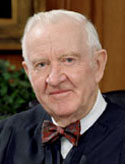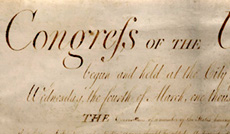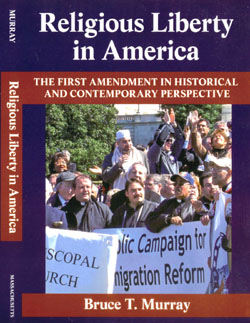From gun rights to religious liberty

Legal theories in recent First and Second Amendment cases shed light on ‘judicial activism’ vs. restraint
By Bruce T. Murray
Author, Religious Liberty in America: The First Amendment in Historical and Contemporary Perspective
A 2010 Supreme Court case involving gun rights raises curious parallels – and incongruities – with several religious liberty cases that touch on the same constitutional issues regarding state’s rights, individual rights and the powers of the federal government.
 In the case of McDonald v. Chicago, the Supreme Court declared that the right to bear arms is a fundamental right, and this right applies equally in all 50 states and their various municipalities. The Second Amendment previously applied only to the federal government, restricting Congress from passing laws infringing on the right to bear arms. In McDonald, the Court ruled to “incorporate” the Second Amendment, meaning the amendment now applies to all state, municipal and federal jurisdictions.
In the case of McDonald v. Chicago, the Supreme Court declared that the right to bear arms is a fundamental right, and this right applies equally in all 50 states and their various municipalities. The Second Amendment previously applied only to the federal government, restricting Congress from passing laws infringing on the right to bear arms. In McDonald, the Court ruled to “incorporate” the Second Amendment, meaning the amendment now applies to all state, municipal and federal jurisdictions.
The issue of incorporation was also raised in recent years in the context of the First Amendment’s Establishment Clause – “Congress shall make no law respecting an establishment of religion.” In Elk Grove Unified School District v. Newdow, Justice Clarence Thomas opined that the First Amendment’s Establishment Clause should not be incorporated; which, in contrast to the conservative justices’ views on gun rights, means that individual states would be free to legislate on certain matters respecting religion, such as the placement of religious symbols in public places, prayers at high school graduations, and the content of school curriculum.
Thomas, invoking an “originalist” view of the Establishment Clause, interprets its intent as primarily to protect state religious establishments that still existed when the Bill of Rights was drafted. Several New England states, for example, maintained the Congregationalist Church as the official state religion well into the 19th century. Massachusetts did not do away with its Congregational establishment until 1833; Connecticut disestablished in 1818.
 “I accept that the Free Exercise Clause, which clearly protects an individual right, applies against the States through the Fourteenth Amendment. But the Establishment Clause is another matter,” Thomas wrote in Newdow. “The text and history of the Establishment Clause strongly suggest that it is a federalism provision intended to prevent Congress from interfering with state establishments. Thus, unlike the Free Exercise Clause, which does protect an individual right, it makes little sense to incorporate the Establishment Clause.”
“I accept that the Free Exercise Clause, which clearly protects an individual right, applies against the States through the Fourteenth Amendment. But the Establishment Clause is another matter,” Thomas wrote in Newdow. “The text and history of the Establishment Clause strongly suggest that it is a federalism provision intended to prevent Congress from interfering with state establishments. Thus, unlike the Free Exercise Clause, which does protect an individual right, it makes little sense to incorporate the Establishment Clause.”
Thomas’s view of Establishment Clause backtracks on longstanding Supreme Court precedent. In 1947, the Court incorporated the Establishment Clause in the landmark case, Everson v. Board of Education of the Township of Ewing. Following Thomas’s view, under an unincorporated Establishment Clause, states could theoretically re-establish state churches – or take lesser action respecting that end.
“Congress need not observe strict separation between church and state, or steer clear of the subject of religion. It need only refrain from making laws ‘respecting an establishment of religion’; it must not interfere with a state establishment of religion. For example, Congress presumably could not require a State to establish a religion any more than it could preclude a State from establishing a religion,” Thomas wrote in Cutter v. Wilkinson.
Although Thomas argued against incorporation in these two religious liberty cases, in McDonald v. Chicago, Thomas sided with his fellow conservatives, thus taking the opposite view in regards to incorporation of the Second Amendment.
Thomas is not alone in promulgating theories that seemingly flip-flop from amendment to amendment. On his opposing ideological side, Justice John Paul Stevens upholds the incorporation of the Establishment Clause, but his opinions on the Second Amendment bear a close resemblance to Thomas's views on the First:
 “By its terms, the Second Amendment does not apply to the States; read properly, it does not even apply to individuals outside of the militia context. The Second Amendment was adopted to protect the States from federal encroachment,” Stevens wrote in his dissenting opinion in McDonald (emphasis added). Compare the similarity of Stevens' words to Thomas, as he wrote in Newdow: “The text and history of the Establishment Clause strongly suggest that it is a federalism provision intended to prevent Congress from interfering with state establishments.”
“By its terms, the Second Amendment does not apply to the States; read properly, it does not even apply to individuals outside of the militia context. The Second Amendment was adopted to protect the States from federal encroachment,” Stevens wrote in his dissenting opinion in McDonald (emphasis added). Compare the similarity of Stevens' words to Thomas, as he wrote in Newdow: “The text and history of the Establishment Clause strongly suggest that it is a federalism provision intended to prevent Congress from interfering with state establishments.”
Pick a clause, any clause
Although Thomas’s vision of a selectively incorporated First Amendment, with the Religious Liberty Clauses bifurcated, is generally considered extreme, the general concept of selective incorporation is not.
 Prior to the Civil War, the Bill of Rights was applied only to the federal government and not the states. After the Civil War, the Fourteenth Amendment was adopted in order to, among other things, prevent Southern states from backsliding on citizenship rights granted to former slaves. Through the Fourteenth Amendment’s Due Process Clause, most, but not all elements of Bill of Rights have since been applied to the states. The landmark Slaughterhouse Cases (1873) put the brakes on full incorporation and set the precedent for selective incorporation – which, following court precedent, exempts states from certain procedural aspects of the Bill of Rights, such as the Fifth Amendment's requirement of indictment by grand jury and the Seventh Amendment right to a jury trial in civil cases.
Prior to the Civil War, the Bill of Rights was applied only to the federal government and not the states. After the Civil War, the Fourteenth Amendment was adopted in order to, among other things, prevent Southern states from backsliding on citizenship rights granted to former slaves. Through the Fourteenth Amendment’s Due Process Clause, most, but not all elements of Bill of Rights have since been applied to the states. The landmark Slaughterhouse Cases (1873) put the brakes on full incorporation and set the precedent for selective incorporation – which, following court precedent, exempts states from certain procedural aspects of the Bill of Rights, such as the Fifth Amendment's requirement of indictment by grand jury and the Seventh Amendment right to a jury trial in civil cases.
In the Slaughterhouse Cases, the Court held that the Fourteenth Amendment’s Privileges or Immunities Clause includes only those rights that “are dependent upon citizenship of the United States, and not citizenship of a State” – thus excluding the rights enumerated in the Bill of Rights. Subsequent courts, rather than overturning the Slaughterhouse Cases, simply went around the precedent by incorporating the Amendments through the Fourteenth Amendment's Due Process Clause. The McDonald Court did the same in its method of incorporating the Second Amendment.
The plaintiffs' legal strategy in McDonald sought to overturn the Slaughterhouse Cases, thus potentially triggering a wholesale incorporation of the Bill of Rights – not just the Second Amendment. However, the Court declined to overturn Slaughterhouse, and instead focused on due process and the theory of “ordered liberty” – whether the Second Amendment right is “fundamental to the American scheme of ordered liberty and deeply rooted in this Nation’s history and traditions.” The Court's answer, by a narrow 5-4 vote, was “Yes.”
If the Court had taken the route of overturning Slaughterhouse, thereby incorporating the entire Bill of Rights, Thomas’s idea to selectively unincorporate the Establishment Clause would be moot. Thomas, in advocating for a renewal of the Privileges or Immunities Clause over the Due Process Clause, urged a partial rejection of Slaughterhouse, potentially placing his theories regarding the First Amendment at odds with the Second. In his McDonald opinion, Thomas hedges against this possibility:
“I do not endeavor to decide in this case whether, or to what extent, the Privileges or Immunities Clause applies any other rights enumerated in the Constitution against the States,” Thomas wrote. “Nor do I suggest that the stare decisis considerations surrounding the application of the right to keep and bear arms against the States would be the same as those surrounding another right protected by the Privileges or Immunities Clause.”
See more on the “clausal war” here.
Judicial activism or restraint?
 Arguments in the McDonald case and Thomas’s opinions in Newdow and Cutter bear some striking similarities. According to Thomas, the primary purpose of the Establishment Clause is to “prevent Congress from interfering with state establishments.” Similar arguments are commonly made regarding the purpose of the Second Amendment: “One function of the Second Amendment is to prevent the national government from interfering with state militias,” Judge Frank H. Easterbrook, chief judge for of the Seventh Circuit Court of Appeals, wrote for Court in NRA v. Chicago (a combined case with McDonald).
Arguments in the McDonald case and Thomas’s opinions in Newdow and Cutter bear some striking similarities. According to Thomas, the primary purpose of the Establishment Clause is to “prevent Congress from interfering with state establishments.” Similar arguments are commonly made regarding the purpose of the Second Amendment: “One function of the Second Amendment is to prevent the national government from interfering with state militias,” Judge Frank H. Easterbrook, chief judge for of the Seventh Circuit Court of Appeals, wrote for Court in NRA v. Chicago (a combined case with McDonald).
But the effects of the two propositions – incorporating the Second Amendment and unincorporating the Establishment Clause – cut in different ideological directions: Incorporation of the Second Amendment prevents state governments from infringing on the right to bear arms – an idea generally promoted by Conservatives; while incorporation of the Establishment Clause has restricted state governments from doing as they wish in matters respecting religion – a more Liberal approach.
Also, whereas the conservative Court now considers gun ownership an individual right – as opposed to the collective right of a state’s militia – by contrast, Thomas’s theory against incorporation of the Establishment Clause is based, in part, on his belief that it does not represent an individual right, as he opined in Newdow.
The situation shows, yet again, that the concepts of judicial activism and judicial restraint are moving targets. While only the most conservative – or perhaps radically conservative – legal theorists would support unincorporation (or partial incorporation) of the Establishment Clause, the conservative majority on the Supreme Court effected the incorporation of the Second Amendment. Thus, a conservative court can become an activist court in order to achieve its own particular ends, just as earlier liberal courts have done the same.
More analysis of McDonald v. Chicago
Part II: ‘Clausal warfare’
Debate about arcane legal concepts reveals justices' philosophy on fundamental rights
Part III: Originalism and African-American history
For justices who follow ‘originalist’ thinking, history reveals the law
 Thomas’s judicial philosophy and the issue of judicial activism vs. restraint are further discussed in the University of Massachusetts Press book, Religious Liberty in America: The First Amendment in Historical and Contemporary Perspective by Bruce T. Murray.
Thomas’s judicial philosophy and the issue of judicial activism vs. restraint are further discussed in the University of Massachusetts Press book, Religious Liberty in America: The First Amendment in Historical and Contemporary Perspective by Bruce T. Murray.
Further reading
Memorial and Remonstrance Against Religious Assessments
James Madison guides Virginia away from an establishment of religion. Presented to the General Assembly of Virginia in 1785.
Establishment and Disestablishment at the Founding
Michael W. McConnell, William and Mary Law Review, Vol. 44, 2003
The Origins and Historical Understanding of Free Exercise of Religion
Michael W. McConnell, Harvard Law Review, 103.7, 1990
Justice Thomas and Partial Incorporation of the Establishment Clause
Richard F. Duncan, Regent University Law Review, Vol 20:37.
Duncan supports the view of a “partial incorporation” of the Establishment Clause.
Gunfight: The Battle Over the Right to Bear Arms in America
Book review of Adam Winkler's survey of the 2nd Amendment and the landmark gun control case, Columbia vs. Heller. By Jim Newton, Nov. 13, 2011, Los Angeles Times.

